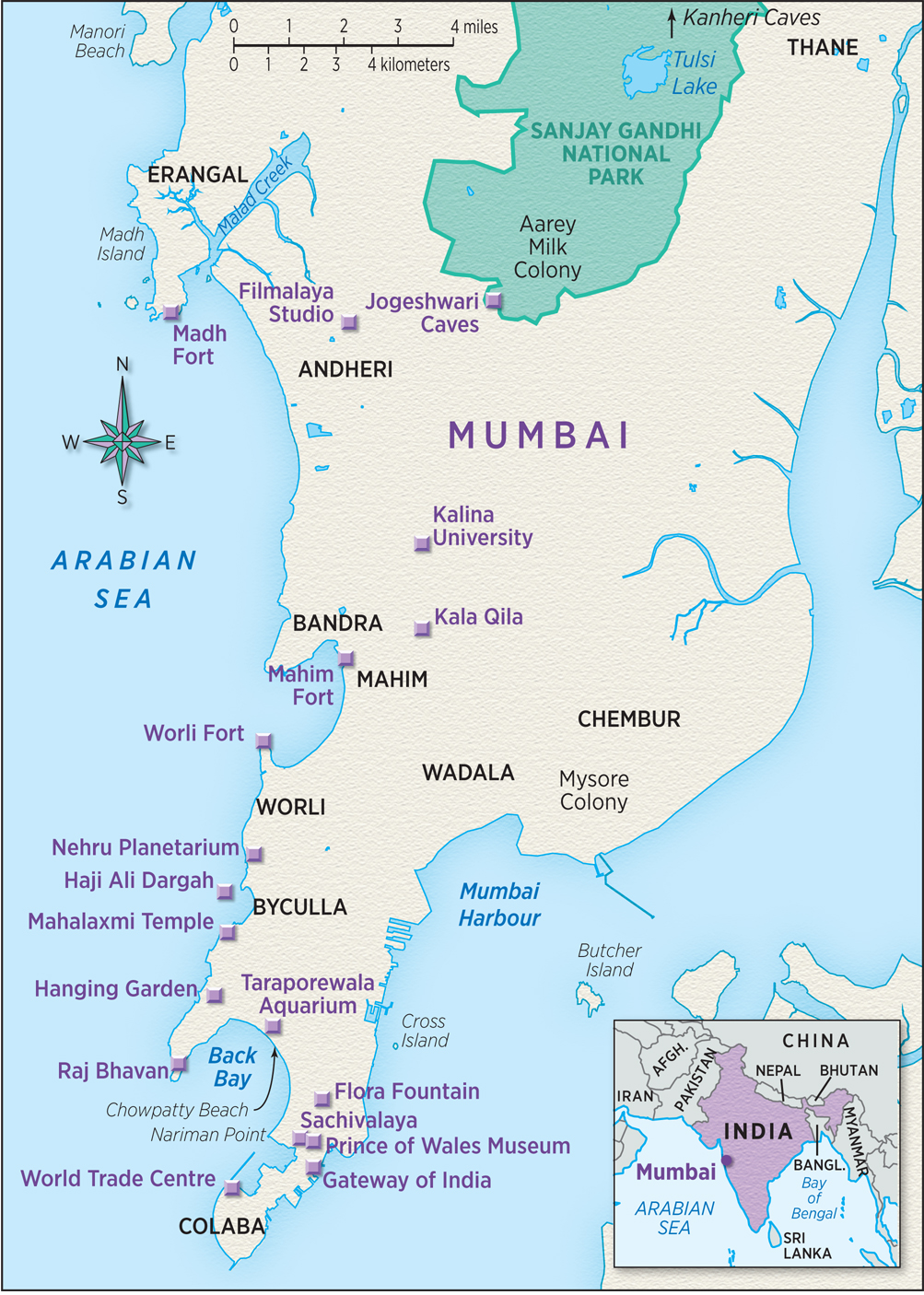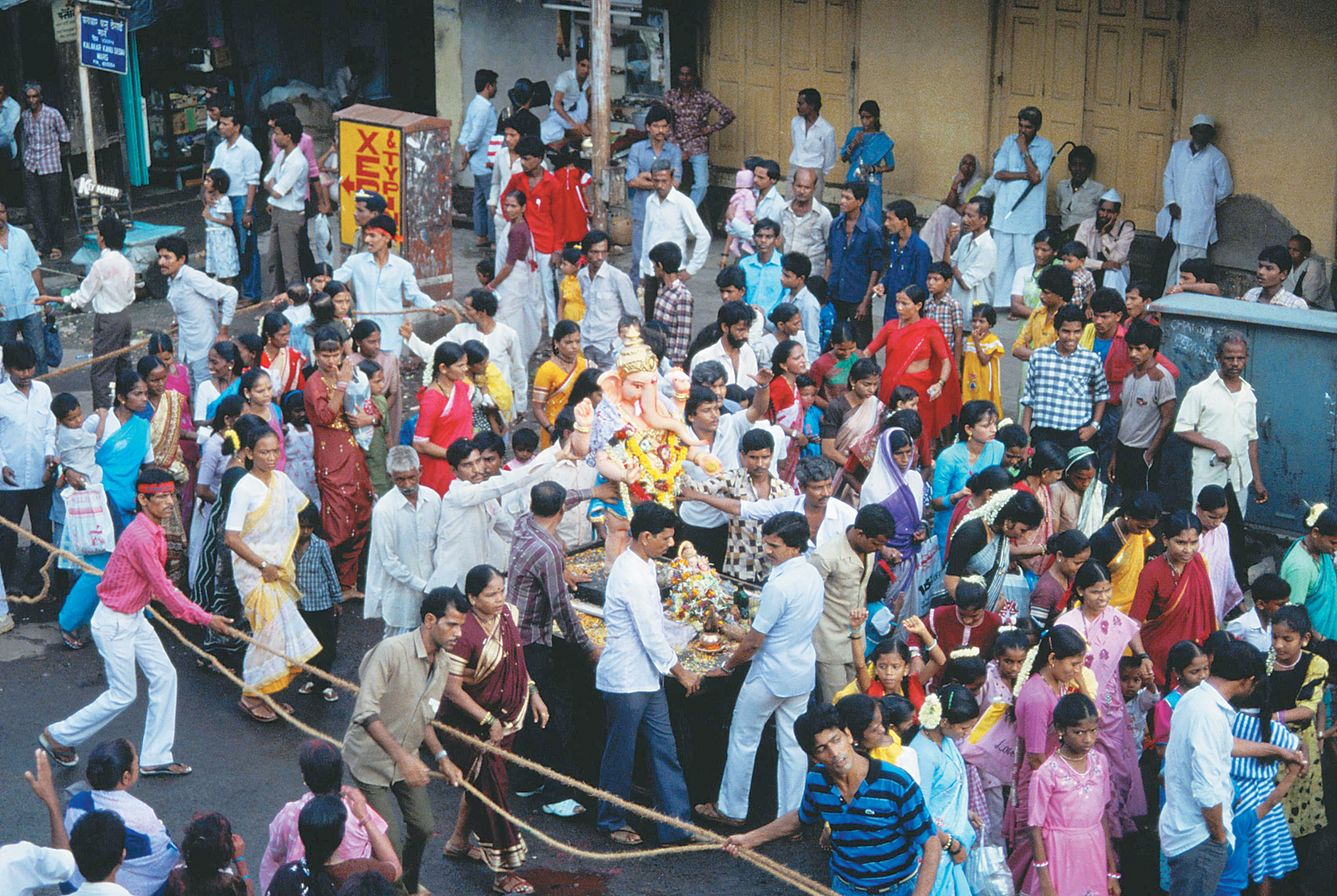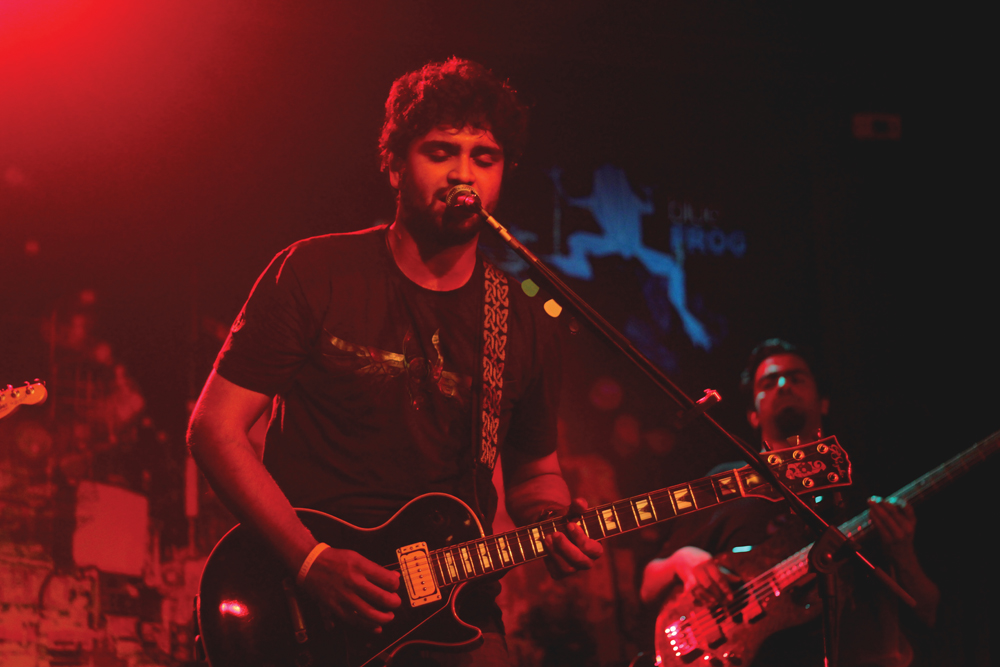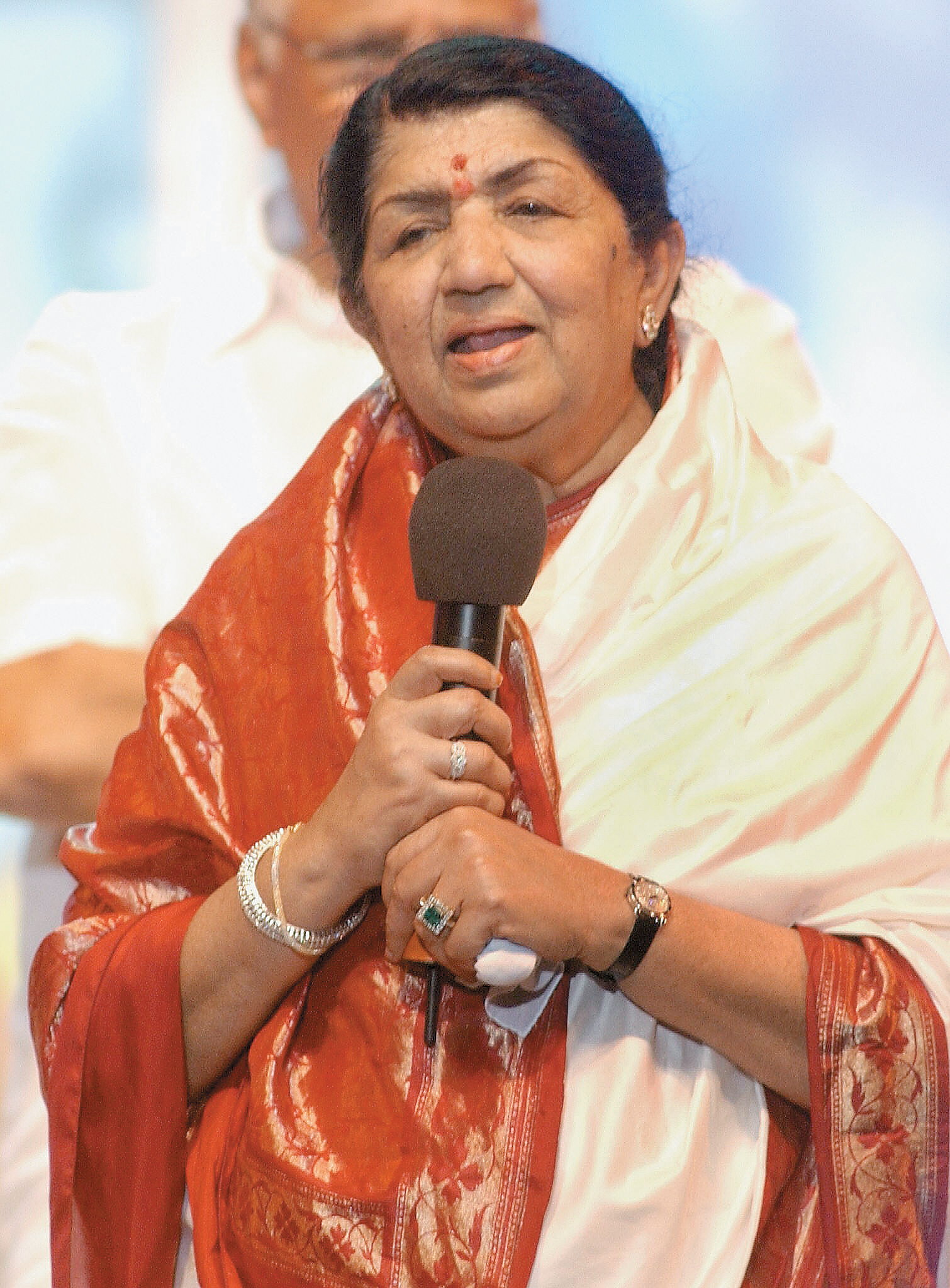CASE STUDY: MUMBAI, INDIA
Mumbai—until 1996 known as Bombay—is a massive city of twenty million people set on a peninsula off the west coast of the Indian subcontinent. Mumbai has been the capital of its region since India’s independence from Great Britain in 1947, and the capital of Maharashtra State since 1960. The area was first settled by Koli fisherfolk who immigrated south from Gujarat more than two millennia ago, and was subsequently ruled by Hindu and then Muslim kingdoms. The entry of a series of foreign forces, beginning with the Portuguese and culminating with the longtime British colonial presence, ensured that this heterogeneous city of people from all over India would become a truly global city. Mumbai is India’s most international metropolis, but at the same time it maintains its distinctive local identities. Some neighborhoods are dominated by particular linguistic, ethnic, or regional ties; others are quite heterogeneous. Music similarly ranges from distinctive styles reflecting local practices to national and international genres.
Mumbai was originally an island city, with the section south of Mahim created by draining and filling in what once were seven islands dotting the harbor. The area south of Mahim is known as the Mumbai City district, or the Island City, while the area to the north is the Mumbai Suburban district.
In sum, Mumbai blends traditions and innovations from every region, city, and village in India. In the southern part of the city is India’s Wall Street (Dalal Street) where most of the country’s corporations have their headquarters. An industrial capital, Mumbai has a port that accommodates global shipping traffic and serves as India’s gateway to the world. Mumbai is also famous as the site of the Hindi film industry, often called “Bollywood,” the largest in the world in terms of personnel and number of films produced. Despite Mumbai’s wealth, skyscrapers, and extraordinary examples of Victorian and Art Deco architecture, much of its population lives in poverty, many in shacks without plumbing or electricity, in a massive shantytown said to be Asia’s largest slum. Others are homeless altogether.
Despite the city’s overwhelming size and complexity, the people of Mumbai acknowledge a sense of cohesion and unity. Whatever their different religions, ethnic backgrounds, or economic status, all are Mumbaikars (what used to be called “Bombayites”), a shared identity said to be stronger in Mumbai than elsewhere in India. The two official languages of the city—Marathi and English—are heard alongside Hindi, Gujarati, and Urdu. There is a Hindi saying that “next to Mumbai city, the rest of India is a village”—an example of Mumbai’s pride of place and its people. This oneness was severely tested during 1992–93, when destructive riots grew out of tensions between Hindu and Muslim factions, and again in 2008 by terrorist attacks, but the city still maintains its distinctive street dialect, a mixture of the Marathi, Gujarati, and Hindi languages. Much of Mumbai’s oneness is manifested in and supported by its musical life, from sustaining music of its distinctive local festivals, to nurturing regional dances, to creating cosmopolitan forms in film music.
THE GANESH CHATURTHI FESTIVAL
Most urban areas have events that celebrate their sense of place. In Mumbai, the ten-day Hindu Ganesh Chaturthi Festival leads off the pan-Indian festival season every fall. Although Hindus are the majority in Mumbai, there are sizeable Muslim and Christian populations, as well as smaller communities of Jain, Buddhists, Sikhs, Parsis, and Jews. Within this multiethnic and multireligious setting, the Ganesh Chaturthi Festival was transformed in the late nineteenth century from a domestic Hindu celebration to a community-wide festival promoting solidarity and independence from the British. Today Ganesh Chaturthi, which falls at the end of August or the beginning of September, remains a citywide festival that crosses ethnic and religious lines and includes a wide array of musical performances.
A procession through the streets of Mumbai during the Ganesh Chaturthi Festival.
The Ganesh Chaturthi Festival marks the birthday of Lord Ganesh, one of the most popular Hindu deities, the elephant-headed God. According to one of many competing versions of Hindu mythology recorded in the Puranas, a collection of ancient Sanskrit stories, Ganesh was the son of Parvati (also known as Mumba, from whom the city of Mumbai took its name); Parvati was the wife of Shiva, the Hindu God of destruction. One day, when Ganesh kept watch outside as his mother took a bath, Lord Shiva came looking for his wife. Ganesh did not allow him to enter and Shiva became furious and cut off Ganesh’s head. Finding out afterwards that the guard was his son, Shiva ordered his servant to bring the head of the first living male he encountered; the servant returned with the head of an elephant, and it was joined to the boy’s body. “Gaj” means elephant and “anan” means head, so Parvati’s son became known as “Gajanan.” Shiva subsequently made him the deity of his armies and thus his name became Ganesh (“Gan” = “army” “Ish” = “god”) or, Ganpati, which means “The Lord of Hosts.”
Ganesh is the God of learning and of auspicious beginnings, addressed as the “Remover of Obstacles” (“Vignaharta”). His devotees consider Ganesh the embodiment of both Shiva and Vishnu, the God regarded as preserver and protector of the universe. It is believed that no new enterprise will succeed unless Ganesh is invoked, and therefore the image of Ganesh is found everywhere in representations mounted on the doorways of houses and pictures reproduced on wedding cards.
 |
“DRUMMING FOR GANESH: MUSIC AT PUNE’S GANPATI FESTIVAL” PART 1 |
 |
“DRUMMING FOR GANESH: MUSIC AT PUNE’S GANPATI FESTIVAL” PART 2 |
 |
“DRUMMING FOR GANESH: MUSIC AT PUNE’S GANPATI FESTIVAL” PART 3 |
 |
“DRUMMING FOR GANESH: MUSIC AT PUNE’S GANPATI FESTIVAL” PART 4 |
During the days of the festival, images of Ganesh made of clay are displayed in homes. These images are worshipped privately both morning and evening, with prayers and offerings of flowers and incense. There are also public performances of bhajan (devotional songs) as well as dance, acrobatic, and dramatic presentations in various urban venues.
On the tenth day, the clay images are brought out and ceremonially immersed (visarjan) in water, whether in the sea, a river, or a nearby well. The festival’s final day is one of frenetic activity. From dawn to dusk, the streets are choked with people. Loudspeakers broadcast music, including film songs, electronic remixes of traditional Marathi folk songs, and bhajans. During the closing procession, people chant in Marathi, “Ganapathi bappa Moraya, Pudcha varshi lavkarya” (“Father Ganpati, Lord of Moraya, come again quickly next year”). Today, both in Mumbai and in the worldwide Indian diaspora, recordings of prayers for Ganesh such as that heard in Listening Guide 23 are widely distributed, having replaced live priests at worship services.
The recording of Praise Ganesh in Listening Guide 23 demonstrates the union of local and global musical influences on several levels. The prayer is a traditional Hindi hymn of praise (Aarati) sung at the end of a worship service (puja). The name of the prayer, Aarati, literally means a worship lamp or candles that are waved during Hindu rituals in front of an image or icon of a deity.10 Singing the Aarati atones for any mistakes or errors inadvertently committed during the ritual. Therefore this recording, which would probably be played at the end of a worship service devoted to Ganesh, permits Hindus to perform a ritual on their own without a priest while ensuring that they maintain appropriate standards. The sounding of the conch shell (shankh) and the use of the six-beat rhythm (dadra tal) connects the recorded prayer with Hindu worship. The other instruments in the recording, however, including the vibraphone, sitar, and especially the zither (swaramandal), are familiar from recordings where they provide accompaniment to several types of music, including popular, classical, and devotional music.
 1:31 |
Date of recording: 1999 Performers: Sanjeev Abhyankar and Chorus Form: Hindu Aarati Function: Recording to be played at end of worship service (puja) for Ganesh to rectify any mistakes or faults in the ritual just performed |
WHAT TO LISTEN FOR:
• Entry of a series of Indian musical instruments, including the plucked lute (tanpura), plucked zither (swaramandal), conch shell (shankh), double-reed aerophone (shehnai), paired membranophones (tabla), finger cymbals, and plucked lute (sitar)
• Use of instruments such as the zither and lute, as well as the vibraphone,* to provide atmosphere and resonance to the recording
• Use of six-beat rhythmic pattern (tala) in drums and cymbal
• Repetition of the ritual text by male vocalist and female chorus
• Substitution of the Marathi expression “Jaki” (language spoken in Maharashtra, the state in which Mumbai is situated) for the Hindi expression “Jay ki” (“praise to”), within this Hindi prayer
* The vibraphone is a twentieth-century Western electrophone (similar to a xylophone) incorporating a motor that produces vibrato.
|
STRUCTURE AND TEXT |
DESCRIPTION AND TRANSLATION |
0:00 |
|
Tanpura enters and plays constant drone. |
0:01 |
|
Zither (swaramandal) enters and provides atmosphere with descending glissandos, rapid slides down the scale. |
0:09 |
|
Conch shell enters, signaling connection to Hindu worship. |
0:18 |
|
Vibraphone enters, provides atmosphere, quickly fades to background. |
0:23 |
|
Double-reed aerophone enters, its melody not set in a particular rag. Drum introduces rhythmic cycle (tala) of six beats used in devotional music. Finger cymbals play on beats 1 and 4 of cycle; open stroke of one cymbal against the other on beat one (letting both ring) and a closed stroke on beat 4 (cymbals are held against each other, damping the sound). |
0:28 |
|
Sitar enters, traditionally a solo instrument, here in a minor accompanying role. |
0:47 |
Chorus enters |
|
|
Jay Ganesha, Jay Ganesha, Jay Ganesha Deva |
Praise Ganesh, Praise Ganesh, Praise Lord Ganesh (repeated) |
0:56 |
Male soloist enters |
|
|
Mata Jaki Paravati, Mata Jaki Paravati Pita Mahadeva |
Praise his Mother, Paravati, Praise his Mother, Paravati, And his father Mahadeva (the Hindu god Shiva) |
1:06 |
Chorus |
|
|
Jay Ganesha, Jay Ganesha, Jay Ganesha Deva |
Praise Ganesh, Praise Ganesh, Praise Lord Ganesh (repeated) |
1:16 |
Sitar interlude |
|
1:29 |
|
Fade-out. |
MUSIC OF MUMBAI’S ETHNIC COMMUNITIES
Much of the population of Mumbai participates in festivals such as Ganesh Chaturthi, but there are many other aspects of musical life that take place within a subset of the larger community.
The Koli community, the first residents of the area, continue to be a presence in Mumbai; the men fish and the women sell their catch at local markets along the docks. Koli fishing communities live today in a vastly transformed environment, surrounded by expensive offices, apartments, and hotels. Aspects of Koli traditional culture, such as the distinctive nine-yard green saris worn by Koli women, their Marathi dialect, and their musical traditions, are actively perpetuated, spurred in part by the interest of tourists. Koli folk songs are widely distributed on recordings and can be heard over loudspeakers in their neighborhoods.
Folk songs in Marathi are heard everywhere in Mumbai; they address universal topics such as love as well as subjects of local concern, such as monsoons, the intense storms that strike Mumbai during the rainy season. Some of these folk songs are subsequently reintroduced and popularized through electronic remixes that become well known and then quickly give way to newer entries. One good example is the monsoon song Dhagala Lagli Kala by Baba Kandke, which talks about the coming rain as seen through the eyes of a flirting couple.
The band Spook, a pop-rock alternative band, performs at the popular Blue Frog Club in Lower Parel, a central hub located between Wadala and Worli in Mumbai City, India.
North Indian classical music is also actively represented in Mumbai. The native scholar-musician Pandit V. D. Paluskar established a music conservatory, Gandharva Mahavidyalaya, in 1911, where students could study Hindu devotional music and culture. Other important figures included Pandit Vishnu Narayan Bhatkhande (1860–1936), who established a music school to perpetuate North Indian (Hindustani) music in early-twentieth-century Bombay and published books about the Hindustani musical system and collections of musical compositions. The study of classical Indian music in Mumbai has been maintained both as an artistic pursuit and as an expression of national, ethnic, and religious identity.11
European classical music has exerted an influence since the arrival of the British in India during the seventeenth century. The nineteenth-century colonial government established educational institutions following British models, founding a university in Bombay in 1857 and later supported private colleges.12 The Parsi community, which migrated to India from Iran as early as the seventh century and settled in Bombay beginning in the seventeenth century, became, along with members of the Anglo-Indian community, well known for patronizing European classical music. The National Centre for the Performing Arts became in the twentieth century an important venue for Western-influenced ensembles such as the Bombay Chamber Orchestra and visiting Western groups, but also a space for a wide array of North and South Indian (Karnatak) music, dance, and theater. A variety of international popular musics also share performance venues and audiences at clubs and discos in the metropolitan area and are promoted through groups such as the Mumbai Rock Association and events such as “Dire Straits Night.”
THE MUMBAI FILM INDUSTRY
Film music is everywhere in Mumbai—heard on the street, in shops and stores, on the radio, accompanying loud and colorful wedding processions, broadcast by television music channels, and played in the discotheques and nightclubs. Indian-produced silent films accompanied by live music date back to 1912, and 1930 marked the beginning of Indian-language films with sound, setting the stage for Mumbai to become the center of a new industry. In the early years, singing actors and actresses performed Indian film songs (filmi git) on camera; the music was later rerecorded and released on 78-rpm records. These songs became enormously popular with Indian audiences, and their importance increased in 1935, when new technologies made possible the “playback song,” prerecorded by a professional singer and lip-synched by an actor in the film.13
Over the years, the Indian film industry mushroomed. By midcentury, “Bollywood” specialized in mass-marketed films known as “masala movies,” featuring stereotyped romantic plots with elaborate interludes of song and dance. Over time, the subject matter shifted in response to changes in Indian society and to the influence of the global film industry, in particular the impact of Hollywood. A distinctive dual star system arose: On-screen actors and actresses became superstars, and the studio musicians, called “playback singers,” who performed the songs, were also universally known and lionized. Among the most famous playback singers, beginning in the 1940s and extending throughout the rest of the twentieth century, were Lata Mangeshkar (1929–) and her sisters, who recorded songs in both Hindi and Marathi for thousands of films.14
The renowned playback singer Lata Mangeshkar is cited in the Guinness Book of World Records for having recorded the greatest number of songs.
In the early years of the Bombay film industry, films used the closely related Hindi and Urdu languages of Northern India. By the later twentieth century, Hindi-language films became the industry’s most lucrative products, although there were other smaller movie industries, such as those that used the regional Marathi dialect. From the beginning, there was a symbiotic relationship between traditional music and film music: Traditional Indian musical genres provided a basis for film music, and traditional repertories such as those performed by wedding bands began to change quickly, incorporating the most recent film songs.
One important influence on film music was the Northern Indian Urdu-language song genre, the ghazal, which had long been transmitted in several related forms in both religious and secular contexts. The secular ghazal art song, a strophic song performed for elite audiences in North India, accompanied by the bowed lute (sarangi), the tabla (a pair of drums), and harmonium, gave rise to the “light classical ghazal” that dominated Indian films. Over the decades, the film ghazal waxed and waned in popularity, returning in new pop forms in the late twentieth century, and were widely distributed through recordings.15
Popular music from abroad and trends in the international music industry have deeply influenced Indian film music. For instance, the movie Bombay Boys, directed by Kaizad Gustad and released in 1998, tells the story of three young men who return home to Mumbai after living abroad, only to run into trouble with the Mumbai underworld. The song Mum-bhai (see Listening Guide 24) reflects the musical style of Western gangsta rap while underscoring its local meaning through a pun on the city’s name: Bhai means “big brother” and refers to an underworld figure. The text is in a local dialect that contains some English phrases, while the musical content and form of Mum-bhai is cosmopolitan; a flexible strophic form is set to a regular quadruple meter. Some elements—the repetitive synthesizer melody first heard in the introduction, two choruses singing the refrain “I am Mum-bhai,” and the list of synthesized instrumental sounds just after 2:19—make it clear that Mum-bhai merges international musical trends with local culture. This song, like the festival and dance music we have discussed from Mumbai, exemplifies the locally flavored yet cosmopolitan musical and cultural syntheses that have long characterized music of that city, even as it moves abroad to reach new and expanding audiences around the world.
 3:20 |
Date of recording: 1998 from the film Bombay Boys Composer and performer: Jaaved Jaffery; Kaizad Gustad, director Form: Strophic, with refrain Tempo: Moderate, regular quadruple meter |
WHAT TO LISTEN FOR:
• Regular quadruple rhythm moving at a steady rate of approximately one beat per second
• Changing vocal articulations, moving from speech to heightened speech, to song
• Multilingual text conveying local images
|
STRUCTURE AND TEXT |
TRANSLATION |
DESCRIPTION |
|
0:00 |
Spoken: My name is bhai . . . Mumbhai. |
My name is bhai (Big Brother, or Don . . . ) Mumbhai. |
|
|
0:03 0:40 |
Instrumental introduction Verse Mumbhai ekdum danger place Where you survive if you’ve got the pace You’ve gotta be fast, you’ve gotta be tez You’ve gotta be shaana to win the race. |
Mumbai is a dangerous place Where you survive if you’ve got the pace You’ve gotta be fast, you’ve gotta be quick You’ve gotta be smart to win the race. |
Gunshot is heard, followed by rhythm track in regular quadruple beat (4/4), at 60 beats per minute, then synthesizer melody. |
|
0:49 |
Chhota-chhota matter baney police case Bada-bada lafda, gul without trace Ghabraane ka nai—give it in the face Woh kya bolta hai—haan—jaisa des waisa bhes! |
Small-small matters become big police cases Large-large crimes are gone without a trace Don’t worry at all—give it in the face What’s that they say?—oh yes—When in Rome . . . ! |
Singer switches from normal mode of speech to heightened, pitched speech. |
|
0:58 |
Dikhe behti ganga, pocket se nikle kanga Dekh ke lena panga nahin to ho jaayenga danga Some people are bhala changa, some are bhikmanga Cannot judge anybody shareef or lafanga! |
See a girl pass by, your comb should whip out of your pocket And choose your fights carefully, or there’ll be a riot Some people here are good and honest, some are beggars You can’t judge which is which—gentleman or hoodlum! |
|
|
1:07 |
Bhaigiri ko chhod sab—? Bakwaas! Bhai ka under jo rehta—? Bindaas! Bhai ko denga traas, to hoinga woh khallaas Bahenga uska blood just like tomato sauce. . . . |
Without the Don, everything is? . . . Nonsense! All those under the Don’s protection are . . . ? Carefree! Those who will cross the Don, will end up destroyed Their blood will flow just like tomato ketchup. . . . |
Solo and chorus alternate as call-and-response. |
|
1:16 |
Arre Baap re! |
Oh my God! |
|
|
1:18 |
Chorus Khaaneka peeneka marneka jeeneka Chalneka phirneka uthneka girneka Tension nai leneka, bhai se poochneka Kasa kai, bara hai, I am Mumbhai! |
To eat, to drink, to die, to live To walk, to travel, to get up, to fall down— Now don’t get tense, but you’ll need to ask Don to do any of this! How’s it going? Just remember—I am Mumbhai! |
The melody is doubled at the lower octave (that is, it is sung simultaneously by a second voice one octave lower). |
|
1:27 |
Aaneka jaaneka naachneka gaaneka Nahaneka dhoneka hasneka roneka Boom nai marne ka, bhai se poochneka Kasa kai, bara hai, I am Mumbhai! |
To come, to go, to dance, to sing To bathe, to wash, to laugh, to cry— Don’t say a word, but you’ll need to ask Don to do any of this! How’s it going? Just remember—I am Mum-bhai! |
|
|
1:36 |
Rhythm interlude |
|
|
|
1:44 |
Beer bar dance bar—Baar baar lagataar! Note chhaapne ke liye—Solid hai kaarobaar! Bhai ka adda par dikhta hai jo ek baar Udharich reh jaata hai chodke apna ghar baar. |
Beer bars, dance bars!—Anytime, all the time! Counterfeit currency notes!—What a solid business! Anyone who is spotted at the Don’s lair once Will be in his service forever, leaving his home and family. |
|
|
1:53 |
Admission–election, telephone connection, Construction permission, illegal erection, Paisa nu collection, paper nu correction Everything perfection jab bhi leve bhai action |
Be it an admission, an election, or a telephone connection, (If you need) construction permission, or an illegal erection, The extortion of money, or the correction of an exam paper, Everything is fixed to perfection when the Don takes action— |
|
|
2:02 |
Court mein agar jaaenga to bees saal tak thaamba Law and order se to paandu bhai ka haath hai lamba Neta-abhineta, ya ho koi builder Bhai ko dekar supari, karvata hai murder |
If you choose to go to court, you’ll be stuck for twenty years The Don’s reach extends much further than the arms of law and order Be he a leader, a politician, or even just a builder Anyone can be murdered if you pay the Don enough |
|
|
2:11 |
Haath mein suka power hai sab uska aage jhukta Uska khopdi sanak gaya to poora Mumbai rukta! |
He is all-powerful, everyone bows to accept his control When he gets mad, all Mumbai comes to a standstill! |
|
|
2:17 |
|
Silence. |
|
|
2:19 |
Ae—khatam nahi hua . . . chootiye! Ae baas gitaal . . . Piplee . . . ? Ae banjo—chal! Olchestraaa! |
Hey—I’m not done yet, idiot! Hey, bass guitar . . . Flute . . . ? Hey, banjo—come on! Orchestra! |
Change in rhythm; ostinatos begin. Bass begins to play. Flute starts playing. Banjo plays. |
|
2:51 |
C’mon baby! Ha! C’mon baby! Ha! “Choras!” |
C’mon baby! Ha! C’mon baby! Ha! “Chorus!” |
|
|
3.15 |
|
Fade-out. |





